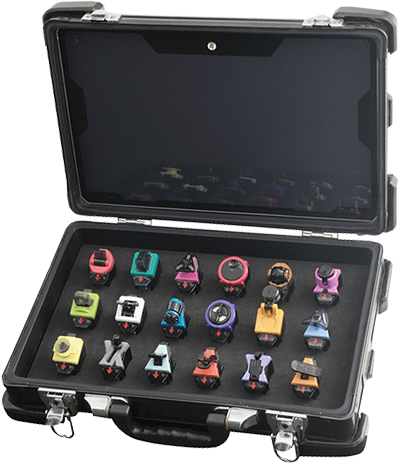Each Hero Is Different: On Forms
Hello, all!
I've been owing you all a new game design check-in about Hero Revolution for a while now, so I figured I would chat a bit about the part of the process that is simultaneously very difficult and very personally inspiring to work on: Hero Forms and Hero Tools.
Wait, what are those?
Forms are the heroic armour that one dons after transforming in Hero Revolution. Much like the game's television touchstone, Kamen Rider, your Form is the source of your power: while transformed, you are much stronger, faster, more agile, and have access to weapons and other equipment that would be difficult if not impossible to wield without it. While you can still fight and hold your own as an unarmed mortal for the most part, a Form makes combat far easier and less risky, especially when confronting multiple enemies at once or a single enemy several times your size. Plus, in some instances a Form is absolutely necessary for victory, in the event that your enemy has a specific weakness a particular Form would be effective against, or if a dangerous situation occurs that only that Form's attached Hero Tools may resolve with ease.
Each form is made up of two parts. The first is a Conduit, the mechanism through which they channel their heroic power, without which they cannot transform at all. In Kamen Rider, that has regularly been a mechanical belt, but it can take many other shapes as well. The second are Catalysts, the modular secondary elements through which they can select alternate Forms from a base type. Catalysts is how Forms differentiate between a Basic Form at the beginning of a campaign to a more powerful one later on, or how you get to play types of heroes with very modular power effects—for example, the Astroswitches of Kamen Rider Fourze would be that protagonist's Catalysts, allowing him to alter his toolset on the fly to apply a different approach to a problem.
Hero Role players will define their initial Conduit and the overall style of their Catalysts alongside the DM during game setup, and gain new forms by spending from their secondary experience point pool (known as wp) to purchase additional Catalysts for future forms.
Sounds rad, right? I hope so! But the challenge I've been working on lately in design is attempting to overcome three specific problems:
- making sure it's open-ended enough for players to be inspired to make their own Hero the way they want; while
- making sure it's streamlined enough for players to be able to make their own Hero easily and without being bogged down by details and choice paralysis.
Let's talk through some of what I've come up with so far—but first...
How It Looks
So outside of the above challenges, there is also a stylistic one: how to make you feel like you're making your own tokusatsu series.
The genre itself is very broad, and even Kamen Rider within it encompasses multitudes of imagery and thematic frames for its heroes, villains, sources of power, and metaphors for power. Some of that is so codified in the franchise that hardcore bugmen nerds know exactly what I mean when I just say the words grasshopper or cobra or skull. It's also why you can point to pretty much any secondary character of any anime wearing a weird helmet riding a bike or a guy in an intense scarf and, dollars-to-donuts, it's a Rider pastiche. But a lot of it is still mechanically very broad and very deep.
Put simply: I want Hero Revolution to still give players the option to play Heroes with large arsenals of Catalysts with very deliberate and cohesive themes, like the Rouse Cards of Kamen Rider Blade or the Core Medals of Kamen Rider OOO: a wide, deep Catalyst pool that still stems from a clear unified singular motif. I also want it to be obvious for players and GMs to be not only able but encouraged to imagine their own Hero motifs for all manner of Catalysts without feeling like they have to play in a similar sandbox to their favourite series or another superhero touchstone.
Making worldbuilding tools that empower GMs to create worlds vastly different than both my own settings and those of my touchstones is key to me as a writer first and foremost: I want to give your play table the chance to write your own epic science fiction story in that frame, and chief among that is finding ways to gift you tools to open up your thematic imagination and draw your own metaphorically rich motifs in play. Cards are Cards in Blade to emphasise the hierarchy of the combatants in its overarching conflict; medals are coins in OOO as a symbolic reference to desire and its capacity to control our wills when unchecked. What will the story of your game mean? I have no idea! But I want to make it easy for you to find out.
So that's one aesthetic problem I've loved chewing into. But here are two mechanical ones...
The Spellbook Challenge
There are lots of versions of solutions to this problem in TTRPG design already. One of the obvious parallels is gaining a spell in Dungeons & Dragons: once you meet the prerequisites for a new one, you flip through the book, think a bit about the things you want to do in the future of your campaign, and then you slot the one you like into your character.
But there are so many spells! Even the ways in which two damage spells in D&D approach actually dealing that damage has to obviously get around potential resistances, the dynamics of the spell's interactions with the environment, and so much more. This is not a judgment per se—some of that variance is what makes choice feel meaningful for some players, and being given a spell as a result of gaining a new item in that framework can feel wonderfully and inspiringly random.
Part of the power fantasy of Kamen Rider and other tokusatsu series, though, is not merely gaining more force of strength, but the sense of gaining exactly the tool you need for the challenge that has just emerged. Your new enemy is powered by seemingly neverending flame? Here is a powerful water-based Catalyst! Your enemy keeps moving too quickly for you to respond? You've unlocked a Catalyst with strong territory-control abilities to keep them in place. Being able to manufacture that experience, both from the player's and the GM's perspective, is key to making sure that some instances of play don't feel like you got into the dungeon with the wrong spell.
This isn't to say that there can't be some variance, of course—it can be just as inspiring for the GM to tell a player they've just earned a new Form after gaining enough wp, without specifically foreshadowing that the new cool power they've gotten will be immediately useful, or even giving them something randomly intriguing in its powerset and nudging the player to think laterally of the various ways they can employ it.
Building A Build-A-Bear Workshop
Of course, the other challenge is making sure it all doesn't feel overwhelming in that more intense way where each individual element of Catalyst creation feels like you have too many valuable choices to make any of them. For one thing, many of those choices can feel either too crunchy or too limiting to make (for instance, if it's too difficult for a GM to agree upon the right wp cost, or how much stress damage it causes); for another, many of those additional benefits, like a particular status effect, may sometimes feel like all good choices that you can't select a single option from.
One solution is to tie the Catalyst cost to a level of complexity: increasing damage or Form resistances, adding additional effects, and so on, would obviously make that Catalyst more expensive than one with a few simple additions. Also, the usefulness of having a Conduit as part of the Hero Tool resource means that you can also upgrade those in order to reduce the cost of more powerful Catalysts, and have it reduce those costs further by coming with a Heroic Condition (for example, a certain number of moves before the Form forcibly shuts down, or a threshold of Basic Form moves you must make before you can use it).
Suffice it to say this is one of the parts of the design process that inspires me most: I am very fascinated to discover new ways to not only put this kind of detail together in some of the adventure setups that will come with the base game, but to overcome the challenge of putting that information together in a way that is both stimulating and easy to follow for players and GMs so that all they have to do is become exactly the Heroes they want to be.
I'm hopeful I will be able to show you some snippets of this and the rest of the overall system that the game uses soon, but in the meantime, I hope this gives you a good sense of my goals, and entices you to see more when I can share it. If you want to support the development of this game in real time before it comes out, and get more updates about its progress, the best way to do so is to support me via Patreon or Ko-Fi. Another good way to keep me on track to work on this game is to buy my other Itch content and comment on the games you have played!
Talk again soon!
Best,
Brandon
Hero Revolution
a game of transformation, redemption, and explosive dropkicks
More posts
- The Risk Mechanic In BriefJan 21, 2023
- Christmas Patch NotesDec 25, 2022
- An IntroductionAug 10, 2022


Leave a comment
Log in with itch.io to leave a comment.